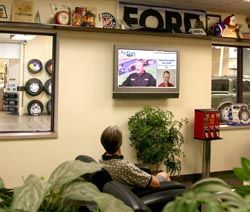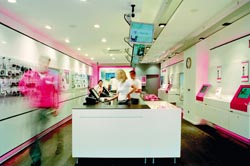- This T-Mobile retail store in the Netherlands uses Adder's X2-Gold CAT5 extenders to transport video, audio and keyboard/mouse signals from back-office PCs to customer-facing LCD touchscreens.You and your end customer may think you've created compelling digital signage content that will stop your target audience in its tracks. But the struggle to create an efficient signage network doesn't end with content. On the contrary, content creation is only the beginning. Now you need to deliver it to servers, distribute it from there to screens, monitor its effectiveness, update it and maintain it. Among other things.
- There are any number of approaches to content delivery, and this is not a cookie-cutter market-one size most definitely does not fit all. In fact, it is the size and scale of the network that may offer the most help when it comes to narrowing down the options.
- "Different customers have different requirements depending upon the size of their system," says Nigel Dickens, technology director at Adder. "In some cases a playout server connected directly to a screen is an appropriate solution, but this can often be awkward to mount and locate next to a screen. In many cases, customers need to locate the playout servers in a secure and easily accessible location that can be some distance from the display screens. This is where some form of video distribution technology is needed to get the digital signage content from the playout server to the screens."
- Increasingly, video-and even audio-quality is seen as a key issue, a fact which reflects widespread industry acceptance that digital signage solutions must have impact if they are to succeed. The boom in dynamic display over the past few years has put screens in almost every kind of public building you can think of, and target audiences are increasingly blasé about them. Now, much like in a supermarket, freshness is as important as quality.
Avocent's wireless solutions are perfect for applications where wired connection between display screens and content servers would be difficult, such as this gas station in Los Angeles.
"We encourage integrators and customers to keep their systems easy to use and maintain," says Matt Nelson of Avocent Corporation, which specializes in wireless delivery solutions that enable integrators to keep installation costs down, thereby releasing additional budget for content updating. "From content creation to delivery, it should never be more complex than a three-step process. First, you create the content; second, it is delivered to the location to be played; and finally it is sent from the player to the display. Designing a system that meets the ongoing digital signage needs of the customer is most important."
Large corporate customers whose networks span hundreds or thousands of screens across state or even national borders will likely want their integrator or channel partner to assist them with content maintenance. But not every client falls into this category. How do you help the smaller players?
With its straightforward, web-based user interface and range of pre-programmed content templates, StrandVision reckons it has a solution that appeals to SMEs for whom signage is only a tiny part of their day-to-day responsibilities. "Our web-based, subscription software provides the means to conveniently select various content types, and easily add or modify slides using information and graphics that customers may already have," says StrandVision founder Mike Strand. "And, our website is available 24/7."
Hardware
So content management is looking after itself-or at least, being looked after. What about the hardware that goes with it? In the future, many digital signage networks will expand organically, embracing different technologies as they go. This inevitably will lead to a requirement for hardware flexibility, which takes us right back to the cables-and-connectors stage in the food chain.
"As digital signage systems become more complex, the video processor installed needs to be more complex in regards to video inputs, outputs and resolutions," believes Dan Gibson, vice president of processor manufacturer TV One. "Our CORIO2 processors are firmware-based, which makes them future-proof especially when it comes to new resolutions. This is particularly important with LED displays, since they come in all shapes and sizes. We can accommodate all the odd resolutions that may pop up."

One couple were encouraged to test-drive a new Mercury Milan after seeing dealer Eau Claire Ford's test-drive advertising wrapped around TV content by StrandVision's digital signage software-and promptly bought the car.
Ten Things To Consider When Creating Content
1.Develop a content strategy that is consistent with your brand objectives. Content must fit in with the marketing and communication aspirations of your company. This includes setting specific content objectives: whether it's to drive up sales, inform employees, or enhance your brand. If possible, quantify your objectives.
2.Know your audience. Find out as much as possible about whom the content is for. Who are your viewers? What are their interests? Appreciate where your audience is viewing the content and their typical "dwell time"-the length of time they'll spend watching the display.
3.Engage other departments, partners, or consultants who may have access to content and/or guidelines for how content should be handled. This step will save a lot of time in the long run and will broaden the depth of content on your network.
4.Make sure content elements are consistent with your corporate branding elements. Consistently use the correct fonts, colors, and logos. Content should have the appropriate tone of message, and overall consistency with brand image.
5.To keep content fresh with little effort, integrate relevant, live data feeds into your screens: weather updates, stock quotes, news tickers, and feeds you create yourself.
6.Select a content management platform that lets you make changes easily, and has more functionality than you need in the short term. This ensures that as your content requirements expand, you won't be caught short with the need for costly new equipment.
7.To save on content costs, repurpose existing assets like video clips, images, web content, and print. Don't assume content will be useable in the same format: you'll need to invest time to re-design, re-format, and re-size content.
8.If you have audio content, make sure it's at an appropriate level for the surroundings. Audio that is too loud or highly repetitive often gets turned off!
9.Measure your results against your objectives. As your marketing and communications objectives change, your content must continuously evolve and improve as well.










